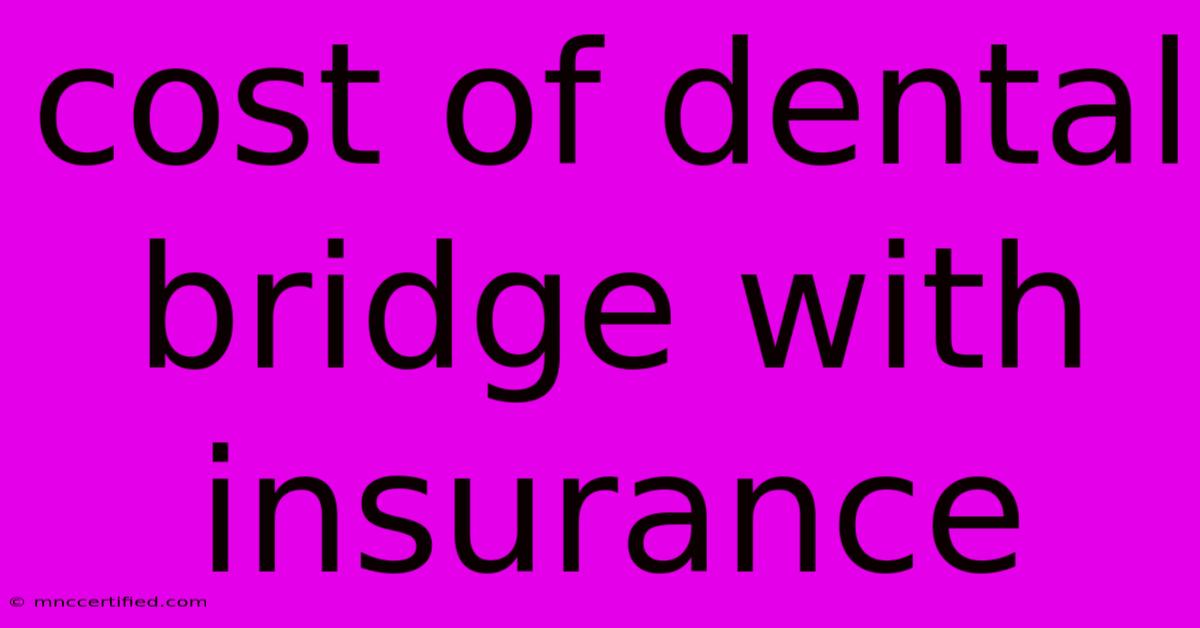Cost Of Dental Bridge With Insurance

Table of Contents
The Cost of a Dental Bridge: Understanding Your Insurance Coverage
A dental bridge is a common and effective solution for missing teeth. It bridges the gap between remaining teeth, restoring your smile and improving chewing function. However, understanding the cost of a dental bridge, especially with insurance, can be a bit confusing. This article will break down the factors influencing the cost and how your insurance coverage can affect your out-of-pocket expenses.
Factors Affecting the Cost of a Dental Bridge
Several factors play a role in determining the final cost of your dental bridge:
- Material: Bridges are made from different materials, each with its own price tag.
- Gold: Gold bridges are the most expensive option, offering superior durability and longevity.
- Porcelain: Porcelain bridges are known for their natural appearance and resistance to staining. They tend to be more expensive than metal bridges but less costly than gold.
- Metal: Metal bridges are generally the most affordable option. They are durable but may not be as aesthetically pleasing as porcelain or gold.
- Number of teeth replaced: The cost increases with the number of missing teeth needing replacement.
- Location of the missing teeth: Bridges in more visible areas (like the front teeth) may require more complex procedures, leading to higher costs.
- Complexity of the procedure: The complexity of your case, including any necessary bone grafts or tooth extractions, can influence the final cost.
- Dentist's fees: Different dentists charge varying fees for their services.
Understanding Your Dental Insurance Coverage
Dental insurance plans vary greatly, so it's crucial to understand the specifics of your policy:
- Benefits: Check your policy to see what percentage of the bridge cost your insurance covers. Most plans cover a certain percentage of the cost, usually 50-80%.
- Annual maximum: Your plan may have an annual maximum limit on dental coverage. This means that your insurance may not cover the entire cost of a bridge if it exceeds your annual limit.
- Deductible: You may have to pay a deductible before your insurance starts covering the cost. This deductible varies depending on your plan.
- Waiting periods: Some plans have waiting periods for specific procedures, like bridges. You might need to wait a certain time before your insurance covers the cost.
Getting a Cost Estimate and Negotiating with Your Dentist
The best way to understand the cost of a dental bridge with your insurance is to contact your dentist. They can:
- Provide a detailed cost estimate: This should break down the cost of each component of the bridge, including materials, labor, and any additional procedures.
- Explain your insurance coverage: They can help you understand what your insurance will cover and how much you will pay out of pocket.
- Discuss financing options: Some dental offices offer financing plans or payment options to make treatment more affordable.
Tips for Saving Money on a Dental Bridge
- Compare dentists: Get quotes from multiple dentists in your area to compare costs.
- Ask about discounts: Many dentists offer discounts for cash payments or for specific groups (e.g., seniors, military personnel).
- Explore alternative options: Consider less expensive alternatives to bridges, such as dentures or implants, if they meet your needs.
Remember: It's essential to discuss your financial concerns openly with your dentist. They can work with you to find the best possible solution for your dental health and your budget.

Thank you for visiting our website wich cover about Cost Of Dental Bridge With Insurance. We hope the information provided has been useful to you. Feel free to contact us if you have any questions or need further assistance. See you next time and dont miss to bookmark.
Featured Posts
-
Bucks Celtics Loss Key Takeaways
Nov 11, 2024
-
Diagnostic Clinic Insurance Accepted
Nov 11, 2024
-
Watch Real Sociedad Vs Opponent La Liga Online
Nov 11, 2024
-
Chelsea Keeps Wsl Title Hopes Alive With Liverpool Win
Nov 11, 2024
-
Best Crm For Health Insurance Agents
Nov 11, 2024